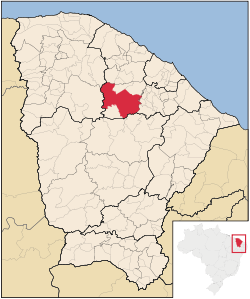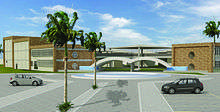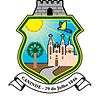Canindé, Ceará
| Canindé | |||
|---|---|---|---|
| Municipality | |||
| The Municipality of Canindé | |||
|
Statue of Saint Francis | |||
| |||
| Nickname(s): Meca Nordestina | |||
 | |||
| Coordinates: BR 3°43′6″S 38°32′34″W / 3.71833°S 38.54278°WCoordinates: BR 3°43′6″S 38°32′34″W / 3.71833°S 38.54278°W | |||
| Country |
| ||
| Region | Northeast | ||
| State |
| ||
| Government | |||
| • Mayor | Celso Crisóstomo (Workers Party (Brazil) | ||
| Area | |||
| • Total | 3,218.423 km2 (1,242.640 sq mi) | ||
| Population (2010) | |||
| • Total | 74,486 | ||
| • Rank | 405th | ||
| • Density | 23.14/km2 (59.9/sq mi) | ||
| Time zone | BST (UTC-3) | ||
| Postal Code | 60000-000 | ||
| Area code(s) | +55 85 | ||
| Website | Canindé, Ceará | ||
Canindé is a Brazilian municipality located in the state of Ceará. It is the 11th most populous city in the state. The religiosity is the main characteristic of Canindé, mainly during the Sain Francis Party that last one entire week and happens once a year. The municipality receives millions of tourists every year, and the most visited places are the Saint Francis statue and the Saint Francis Church.
History
By the intersection of the Curu River and the Choró River was inhabited by Native Brazilians. They were called Tapuia. After the 17th century, Portuguese colonizers started habituating the land. The new inhabitants started agricultural procedures and creation of animals as soon as the got in the land.
In 1775, Xavier de Medeiros, right in the border of the Canindé River, started building a church for Saint Francis. Nowadays, the Saint Francis church is located at the same place; however, it was totally reformulated by the Italian architect Antonio Mazzoti and the painter George Kau. In 1818, Canindé became a village and in July 29, 1846 the Municipality of Canindé was declared.[1]
Geography
climate
Canindé has a Tropical semiarid climate with temperatures that goes from 25 C to 32 C [2]
Soil types
the soil in Canindé is basically composed of non calcium type (55.14%), litholic (12.52%,), others (4.04%)
Fauna
Canindé has a semiarid climate, so most of its fauna is composed of animals that are well adapted to it like the Canindé bird, armadillos, lizards and sparrow-hawks.
Politics
In June 21, 1847 it was installed the city building in Canindé Downtown.
Education

Canindé has 3 public high schools. There are the Paulo Sarasate School, Frei Policarpo School and the School of Professional Education Capelão Frei Orlando.[3] It also has 1 private high school which is the CNEC-Canindé. The city also host a headquarters os a Federal institute of education (IFCE).
References
- ↑
- ↑ "Archived copy" (PDF). Archived from the original (PDF) on 2014-11-06. Retrieved 2014-11-06.
- ↑

